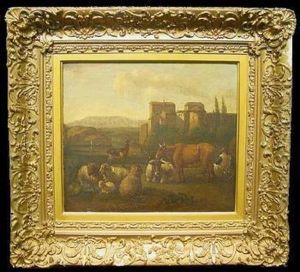N. Berghem Paintings
Nicolaes Pieterszoon Berchem, known as N. Berghem, was a Dutch painter of the 17th century, extensively recognized for his pastoral landscapes imbued with a warm Mediterranean light and lively human and animal subjects. Born in Haarlem in the year 1620, into the golden age of Dutch painting, Berchem was the son of still-life painter Pieter Claesz. He was a part of a circle of artists that included the likes of Jan van Goyen, Pieter de Molyn, and Cornelis Vroom, who were instrumental in developing the Dutch landscape tradition.
Berchem's early training remains somewhat unclear, but it is believed that he studied under his father and possibly under landscape painters Jan van Goyen and Claes van Wouw. However, his style was also influenced by the Italianate landscape painters who were prominent in Utrecht, such as Cornelis van Poelenburgh. Despite the Italian influence, Berchem never actually visited Italy, a fact that did not deter him from adopting the Italianate style characterized by its classical landscapes, warm sunlight, and mythological or biblical themes.
Throughout his career, Berchem was known for his versatility. He painted in a wide range of genres, including not only landscapes but also biblical and mythological scenes, portraits, and animal studies. His works are distinguished by their dynamic compositions, elegant figures, and a soft, golden light. Berchem often included animals like cattle, goats, and sheep in his landscapes, which he rendered with remarkable accuracy and liveliness, helping to establish animal painting as a significant genre in the Netherlands.
Berchem's paintings were highly sought after during his lifetime, and he became a member of the Haarlem Guild of St. Luke. He was a prolific artist, and his works were widely reproduced through engravings, contributing to his international fame. Despite his success, there is little documentation regarding his personal life. Berchem died in Amsterdam in 1683, leaving behind a rich legacy that influenced many landscape painters in Europe. His works are now held in major museums around the world, attesting to his enduring appeal and the significance of his contribution to the Dutch Golden Age of painting.
